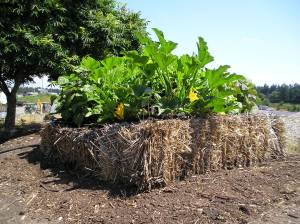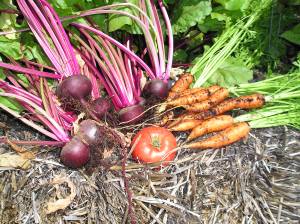I hope you all enjoyed a long weekend with the Presidents’ Day holiday! Over the weekend, I headed to Lewis County to see what the Master Gardeners there were up to. The Lewis County Master Gardeners held an event called “Gardening for Everyone” which featured a slew of presenters on lectures ranging from “Seeds for the PNW” to “Dehydrating Foods.” One class I attended that really captivating was “Alternatives to a Traditional Garden,” particularly the portion about strawbale gardening. Having lived in many places where I have rented housing and/or have had little yard space to work with for gardening projects, this type of gardening made sense to me, and maybe to some of you for whom space is a concern. For strawbale gardening, you may kill the grass under your bales, but with a little grass seed, your landlord will never notice any damages you made to your yard in order to have your bountiful harvest…Maybe you do have the space and you can amend your yard however you please, but making raised beds or tilling a new plot for a garden seems like a daunting task. Perhaps you have poor soil that is not suitable for gardening? Strawbale gardening may be right for you!
You’re probably thinking about your garden more as you notice the increasing number of blooming willows and crocuses in your yard, and maybe you already have bought seeds and have even started them indoors. For strawbale gardening, some ideal seeds and starts are tomatoes, peppers, okra, beans, peas, zucchini, melons, squash, cucumbers, annual flowers, salad greens, and nasturium. You may want to think about getting hay or straw now from farmers that are trying to get rid of their supply for a low price. Straw is ideal, but hay will work too, although hay often contains weed seeds. Once you get your hands on a few bales, hose the bales down and keep them wet for two to three days to get the breaking down process started. The bales will get hot from breaking down, just like compost does. After a few days, add a some medium to the top of the wet bales for seeds that do not need to be started (i.e. lettuces, nasturium, annual flowers). For started plants such as tomatoes and peppers, scoop out some of the straw, remove the plant from its container and fill the hole you made with the plant and the soil in the pot. This is the extent of the work you will do for your strawbale garden aside from watering (and perhaps weeding). Another benefit of strawbale gardening is the beautiful compost you will have from the broken down straw at the end of the season! For more information, please see the strawbale gardening handout from the Lewis County Master Gardeners: http://lewis.wsu.edu/mg/straw%20bale%20gardening%20handout.pdf



Leave a comment